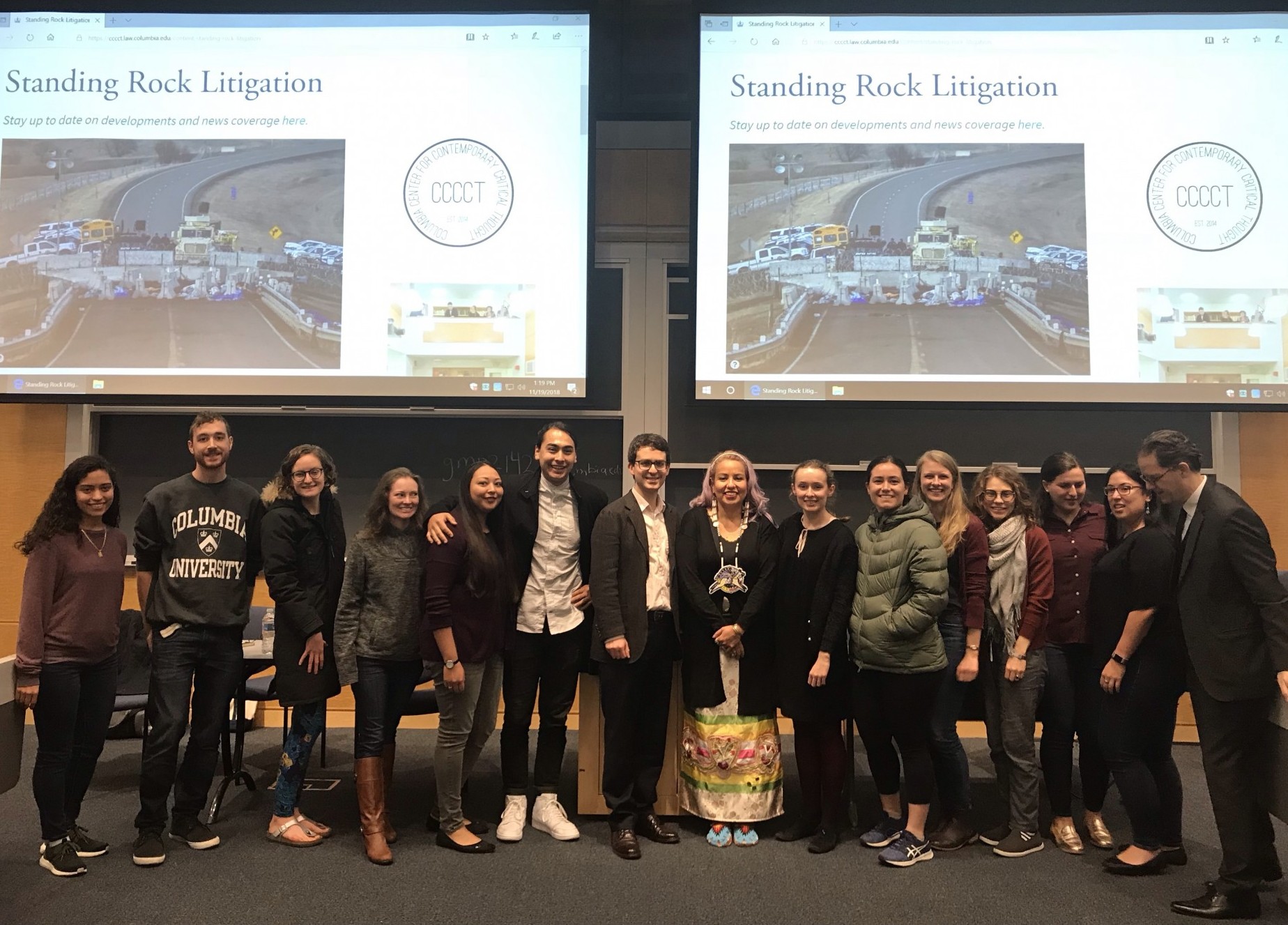Stay up to date on developments and news coverage here.
Thunderhawk v. County of Morton
Read the full amended complaint, Thunderhawk v. County of Morton, filed February 1, 2019.
Cissy Thunderhawk, Wašté Win Young, the Reverend John Floberg, and José Zhagnay filed a class action lawsuit on Oct. 18 in the U.S. District Court for the District of North Dakota challenging a number of civil rights violations that arose during the Standing Rock movement to oppose the construction of the Dakota Access Pipeline (DAPL). They are represented by Professor Noah Smith-Drelich, Assistant Professor of Law at Chicago-Kent College of Law, attorney Amy Knight, and Professor Bernard E. Harcourt, founding director of the Columbia Center for Contemporary Critical Thought and Isidor and Seville Sulzbacher Professor of Law at Columbia Law School.
The Dakota Access Pipeline is a 30-inch diameter pipeline designed to transport up to 570,000 barrels a day of crude, fracked oil from the Bakken shale fields in North Dakota to refineries in Pakota, Illinois. The pipeline was originally planned to cross the Missouri River north of Bismarck. But due to public outcry about the risk of contamination to the water supply, the pipeline company, Dakota Access LLC, rerouted the pipeline to cross the Missouri River less than one mile north of the Standing Rock Reservation boundary. The tribes and their supporters opposed the construction of the pipeline through this area, expressing numerous concerns with the risks presented by the pipeline and with the process by which it was approved at its current route.
The area through which DAPL now runs includes a number of sites of significant cultural, historical, and spiritual value to the Lakota people. The Missouri River is also the sole water source for the two neighboring Lakota tribes, the Standing Rock Sioux Tribe and the Cheyenne River Sioux Tribe, and for many other indigenous and non-indigenous people throughout the region.
From April 2016 through October 2016, one of the primary locations of speech, assembly, and prayer for these individuals was Highway 1806’s wide curtilage near where the pipeline was slated to cross the highway, an area that has long been open to the public for, among other things, use as a thoroughfare, and that could be (and routinely was) visited safely without impeding or disrupting traffic. Plaintiffs regularly engaged in a range of expressive and religious conduct on this land, including hanging prayer ties and signs within sight of passing drivers, as well as speaking and praying individually as well as in small, medium, and large groups.

Defendants and the law enforcement agencies and individuals operating under their control, engaged in a determined and concerted campaign to suppress the speech, assembly, and prayer of the tens of thousands of individuals who traveled, or who intended to travel, through this area to oppose the construction of DAPL. One of the primary methods used by Defendants to chill constitutionally protected conduct associated with the no-DAPL movement was by controlling the roads in a manner designed to discourage no-DAPL travel, speech, assembly, and prayer.
Beginning on October 24, 2016, Defendants closed a significant portion of Highway 1806 to all Water Protector travel—including the entire stretch of Highway 1806 abutting the specifically identified sacred and ceremonial sites as well as the DAPL construction that had been the primary center of Plaintiffs’ speech, prayer, and assembly for the past several months.
Defendants have given varying reasons for the need for this barricade but acknowledge that its target was the Water Protectors. For example, Maxine Herr, a spokesman with the Morton County Sheriff’s Department, stated, about this barricade: “We are trying to create a barrier between the protestors and that private property.” On the other hand, two press releases on October 28 and October 31, gave a different reason for the barricade: the bridge would remain closed “until all damage to the structure is evaluated by bridge engineers.”
This road closure was directed only at Water Protectors: residents of Fort Rice were allowed to drive southbound on Highway 1806 as were employees of DAPL. In fact, DAPL employees were permitted to use the closed portion of the road for the duration of the closure. The stretch of Highway 1806 from the Cannonball River to Fort Rice remained fully closed—at least to Water Protectors—until March 15, 2017. From October 28, 2016 until early March, Defendants maintained a reinforced concrete and concertina wire barricade on Highway 1806 immediately north of the Backwater Bridge. This barricade presented a physical boundary to any travel past the bridge on or around Highway 1806 (but it did not prevent travel onto the bridge itself). Defendants also enforced an absolute prohibition on Water Protector travel—including foot, horseback, and ATV travel—on the closed portion of Highway 1806, regularly arresting Water Protectors who approached the barricade on foot.
The Defendants’ five-month absolute prohibition on any Water Protector travel on an approximately nine-mile stretch of this public right-of-way infringed Plaintiffs’ Fifth and Fourteenth Amendment right to interstate and intrastate travel and, as a consequence, substantially burdened Plaintiffs in seeking needed medical care, in purchasing supplies (and in other ways engaging in commerce), in meeting, speaking and being interviewed by media, in gathering and reporting the news, and in visiting family members.
The travel limitations also prevented Plaintiffs from exercising their First Amendment right to assemble, speak, and pray in the area in question, including but not limited to a nearly nine-mile stretch of a public road abutting numerous sacred and ceremonial sites, as well as portions of the public road near to the pipeline’s path. The road closure also unnecessarily burdened the First Amendment rights of journalists or supporters who wished to join or visit the camps and thereby limited the camps’ and Standing Rock Reservation’s access to the press as well as the press’s access to the camps and to the Standing Rock Reservation.

